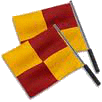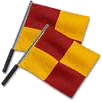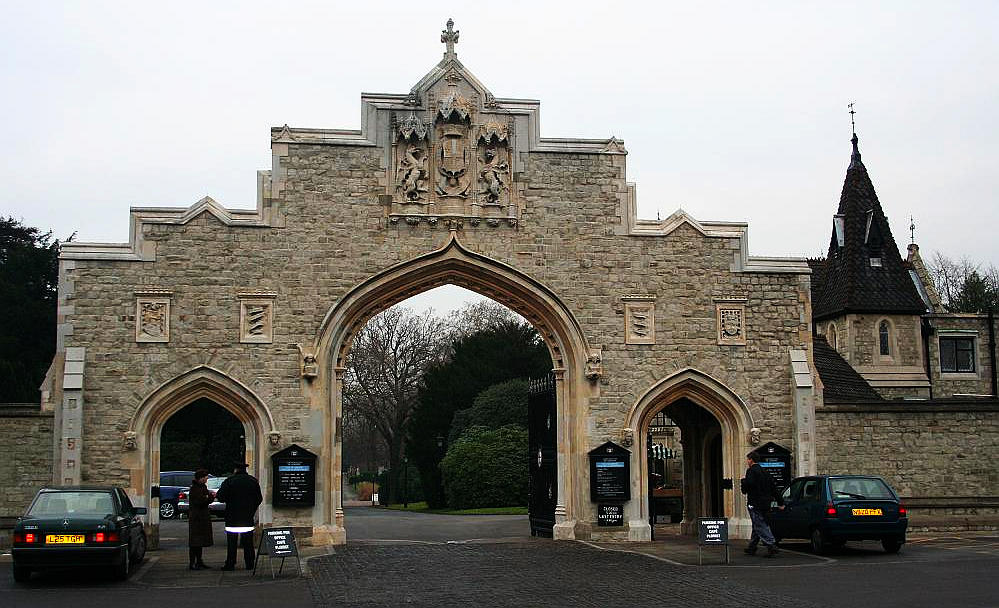|
    
SIR... Kenneth George "Ken" Aston, MBE
(1 September 1915 – 23 October 2001)
Ken would have been old today!
Kenneth George Aston was born in Colchester, Essex and educated at Ilford County High School and St Luke’s College, Exeter,
where he studied French and religious instruction. Immediately after leaving he qualified as a teacher and joined
Newbury Park County Primary School in Essex, where he remained for the rest of his career,
apart from his war service and a year at another school as deputy
headmaster in 1949. Ken Aston had been asked to take charge of a
football match at his school in 1935, and he qualified as a Referee in
the following year. He began in local leagues and progressed to the
Football Combination, where he remained until he joined the list of
league Linesmen in the 1949-50 season. But still qualified as a Referee in 1936, working his way through the
leagues becoming a Football League Linesman in the 1949-50 season,
and becoming a League Referee.
In the Second World War he was rejected by the Royal Air Force because
of an injured ankle, and subsequently joined the Royal Artillery
before transferring to the British Indian Army where he finished the war
with the rank of Lieutenant-Colonel and served on the Changi War Crimes
Tribunal. Having been turned down for the RAF because of an injured
ankle, he eventually served in the Royal Artillery. He was promoted
rapidly, and in 1944 was seconded to the Indian Army. He was among the
first Allied troops into
Singapore, where he served on the Changi War Trials Commission, after
the Japanese capitulation, and he returned home as a lieutenant-colonel.
Ken Aston worked in an era where football transcended from being quite
amateurish in some of its rules, regulations and conduct and it suddenly
transformed to the monster that we are seeing today.
Ken Aston was certainly instrumental in helping to create a tiny part of
the game we see today.
Ken Aston was best known for introducing the Red and Yellow Match Cards.
This is not only is used in Football but also in Rugby, Water Polo and
other games...
After qualifying as Referee in 1936 and becoming a football league
linesman in 1949, he was the first Referee to wear the black uniform
with white trim, which became a standard for referees.
Refereeing...
On his return from military service in 1946, he became the first League
Referee to wear the black uniform with white trim which became the
standard for Referees.
The following year he introduced bright yellow linesmen's flags in place
of the pennants in the colors of the home team which had been used
before.
In 1946 he introduced the bright yellow linesman’s flag in place of the
colors of the home team.
In 1953 he became head teacher at Newbury Park School, London, and
progressed to Refereeing Senior League matches.
As Refereeing was an amateur occupation he in time became a Head Teacher
at Newbury Park School, Near Ilford, London and he progressed to
Refereeing Senior League matches.
In 1957 he was Linesman for the FA Cup Final, Aston Villa v Manchester
United. Aston Villa won 2-1.
In 1960 and this seems to be a conflict of facts, some references say
that he Refereed the European Nations Cup Final, others say he didn’t.
However, he Refereed the Sweden v Norway 1961 World Cup Qualifier and
Refereed 2 games in the 1962 World Cup championship.
The most famous of these being the infamous match The Battle of Santiago
match between Chile and Italy.
This was the first ever match where FIFA intervened on the basis of
video evidence.
Battle of Santiago...
He Refereed the 1960 European Nations Cup final and the 1963 FA Cup
Final, but he is best known for Refereeing the notorious... Battle of
Santiago,
the match between Chile and Italy in the 1962 World Cup.
The atmosphere of this match had been inflamed by Italian journalists'
derogatory descriptions of the beauty and morals of Chilean womanhood,
of the condition of the Chilean capital, and by the Chileans' dislike of
the Italian practice of using South American players with Italian
passports.
Introducing highlights of the World Cup game of 1962 between Chile and
Italy on BBC1, David Coleman said: “Good evening. The game you are about
to see is the most stupid, appalling, disgusting and disgraceful exhibition
of football possibly in the history of the game.” The Referee of the match,
known as the “Battle of Santiago”, was Ken Aston.
The match got off to a vigorous start, with the first player cautioned
within seconds of the game beginning.
After 12 minutes Italy's Giorgio Ferrini had to be escorted off the
field by Ken Aston and armed policemen, who were required twice more
later in the match,
for hacking down the Chilean centre-forward, Landa. Later, Ken Aston
sent off David for a retaliatory kick at the head of the Chilean
outside-left, Leonel Sánchez,
although Sánchez himself was allowed to stay on the pitch despite
breaking the nose of the Argentine-born Italian inside-right, Humberto
Maschio, with a left hook.
He was used to refereeing relatively calm games in England until the 1962 World Cup in Chile.
The trouble there began when the local media claimed that Italian journalists had written articles
which questioned the beauty and morals of Chilean women. Aston, who had taken charge of the opening game,
was regarded as having a safe pair of hands, and as a result was asked to replace the designated official
for Chile’s game against Italy. “I was less than happy,” he said later.
“I asked for my own linesmen, but I had to stick with a Mexican and a little American from New York.
They weren’t very good, so it became almost me... against the 22 players.”
Before the match began, a gift of carnations from the Italian players was rejected by the Chileans.
After 12 seconds, the first player was booked. After 12 minutes, Giorgio Ferrini of Italy was sent off for a cynical foul.
Then the Chilean left back Leonel Sanchez broke the nose of the Italian captain,
Huberto Maschio, with a left hook.
“I had my back to the incident at the time,” said Ken Aston.
“I’m sure the linesman saw it, but he refused to tell me.”
When Mario David later aimed a kung-fu kick at Sanchez,
he was also sent off. Armed police came on to the field three times to help Ken Aston, who did not add on any
stoppage time. Chile won 2-0.
“I wasn’t refereeing a football match,” he later recalled. “I was acting as an umpire in military
maneuvers.”
Although he later advised Referees never to lay a hand on a player, he admitted that on this occasion he had been
“manhandling players left, right and centre”.
He Refereed the FA Cup Final Manchester United v Leicester 1963.
FIFA Referees' Committee...
Ken Aston did not Referee any more games in the 1962 World Cup, having
strained his Achilles tendon.
Ken Aston was then appointed to the FIFA Referee Committee, chairing it
for 4 years, he was in charge of all the Referee’s for the World Cup’s
of 1966, 1970 and 1974. But discipline was not his only priority.
“The game should be a two-act play with 22 players on stage and the Referee
as the director,” he once said. “There is no script, no plot, you don’t know
the ending, but the idea is to provide enjoyment.”
Ken
Aston never refereed another World Cup match, but in 1964 he became
chairman of the FIFA Referees’ committee, a position which he held until
Sir Stanley Rous was succeeded as President of FIFA by João Havelange.
Aston remained FIFAs chief Refereeing instructor.
Red and Yellow Cards...
He retired from domestic football in 1963 after taking charge of the FA
Cup Final. But at the 1966 World Cup, in his role for FIFA, he became
embroiled in another of the most controversial incidents of the history
of the tournament, when England played Argentina in the quarter-final at
Wembley. For an hour of a rough game England were unable to penetrate
the Argentine defense. Then, with the Argentine players surrounding the
German referee, Rudolf Kreitlein, to dispute another decision, their
captain, Antonio Rattín, was sent off.
For several minutes Rattín refused to leave the pitch, and then, when he
did withdraw, he continued the argument in front of the royal box. “The
gesturing went on for three minutes or so, and it became plain to me
that, if no solution could be found soon, the match would have to be
abandoned,” said Ken Aston, who had overall responsibility for
Refereeing at the tournament. “I decided to go on and see what I could
do.” He managed to persuade Rattín that to persist would not be good for
the Argentine football authorities. England won 1-0.
The match became significant for a further reason. Newspapers had
reported that both Jack and Bobby Charlton had been booked, but there
was no public indication of this from the Referee, and the England
manager Alf Ramsey had asked FIFA for clarification.
Rumor has it that in 1966, during the World Cup competition when
sitting at some traffic lights in Kensington High Street, Ken Aston
after watching the changing lights thought,
the use of Red and Yellow card would help in the translation and
language difficulties between referee’s and players, which had occurred
following Jack Charlton incident in
the England v Argentina 1966 World Cup Game. A nice story however there
is no fiction that Ken Aston introduced them into the professional game
of football.
On the trip, punctuated by many traffic lights, Aston realized that a
color coding scheme on the same amber (steady) - red (stop) principle
as used on traffic lights would
traverse language barriers and clarify to players and spectators that
they had been cautioned or expelled.
Thus was devised the system whereby Referees show a yellow card for a
caution and a red card for an expulsion, which was first used in the
1970 World Cup.
In 1966 Ken Aston also introduced the practice of naming a substitute
Referee who could take over in the case of the Referee being unable to
continue for any reason
(this eventually evolved into the practice of having a designated fourth
official).
He also successfully proposed that the pressure of the ball should be
specified in the Laws of the Game.
In 1974 he introduced the number board for substitutes, so that players
could easily understand who was being substituted.
This then saved confusion with players and spectators and both then knew
if a player had either been booked or sent off.
The cards were first used in 1970 World Cup competition.
In 1966 Ken Aston introduced having a fourth official at all games,
which could cover a Referee or Linesman if required.
Ken Ashton proposed the pressure of the ball should be specified in the
laws of the game.
In 1974 he introduced a number board that could be used for substitutes,
so players could understand if they were being required to leave the
pitch for a substitution.
Ken Aston’s confident opinions made him a respected authority on the
laws of the game. As a result, he represented the footballers John
O’Neill and Paul Elliott at the High Court, after their respective
careers were ended by heavy challenges. Ken Aston described one of the
damaging tackles, by John Fashanu, as “the clearest case I have ever
seen of a player jumping at an opponent”.
“I know I’m a bloody old fool,” he once said, “but I think about the
game.”
He
started up Refereeing courses in America, and was able to say: “I have —
and I know
I have — made an enormous difference to the game in the USA.” A
tournament in
California was named after him — in which the winners are the
best-performing Referees and Assistant Referees.
Ken Aston became the Senior Lecturer of the Football Association on the
Referee’s panel. In the USA he was the Chief Referee’s instructor for
the American Youth Soccer Organization.
Ken Aston was an integral part of AYSO for more than 20 years. He
started volunteering during the early 80's and continued to be active in
the organization until his death on October 23, 2001.
Ken Aston was the man who came up with the idea of giving yellow or red
cards in soccer.
Ken Aston had a significant influence on AYSO's referee program. He was
inducted into their Hall of fame in 1997.
There is a cup named after Ken Aston and a training camp for Referees
again in his name.
The American Youth Soccer Organization (AYSO) was established in the Los
Angeles area in 1964 with nine teams.
It was the dream of a group of devoted soccer enthusiasts who started
the organization in a garage.
In 1997 he was awarded the MBE... "for services to U.S. soccer".
He was honored all over the World as a Ground Breaking Referee and in
football terms he changed the face of football.
He was also the author of what he called the “Tehran Memo”, a ruling on
the tackle from behind, which was subsequently outlawed by FIFA, to Ken
Aston’s disgust. “If it’s serious foul play, the player can be sent off,
but not every time,” he said. “In my day, you were allowed to use your
discretion. That’s the same whether it’s Wembley or Hackney Marshes.”
Ken Aston is survived by his wife, Hilda, and by their son Peter.
Ken Aston, MBE, football referee, was born on September 1, 1915. He died
on October 23, 2001, aged 86.
From... Geoffrey R. Gillon
Find a Grave Website - SIR Ken Aston MBE
Thank you for your recent email regarding the late Ken Aston. I have
searched our cremation records for you and can confirm that he was
cremated here at the City of London Cemetery and Crematorium. The
cremation took place on the 6th November 2001 and his ashes were removed
by a family member...
Kind Regards
Shannon Wallace
Shannon.Wallace@cityoflondon.gov.uk
Asst. Bereavement Services Officer
City of London Cemetery and Crematorium
City of London Cemetery and
Crematorium
Also known as: City of London Cemetery, Manor Park
City of London Cemetery and Crematorium is in Aldersbrook Road,
between Wanstead, Little Ilford and Manor Park, East London.
In the early part of the 1900's it was known as Ilford Cemetery,
even though Ilford already had a cemetery in Buckingham Road.
It is now in the London Borough of Newham.
It is often confused with the nearby, privately owned,
Manor Park Cemetery and Crematorium. |
 |
 |
 Candle lit by... From a former Newbury Park Primary School student... Candle lit by... From a former Newbury Park Primary School student...
Saw... Ken Aston by Liverpool Street Station in March (2001) (his ears
are still huge). He had a walking stick but otherwise still looked very
fit for his age. It was only after I walked passed him that I realized
who it was. I stopped to wait for him but by then he had stopped to
light a cigarette and was making hard work of it! Being already very
late for work I decided to walk on...
--- I shall probably always regret not saying at least...Hello
... He was an excellent School Headmaster and will always be
fondly remembered.
|

